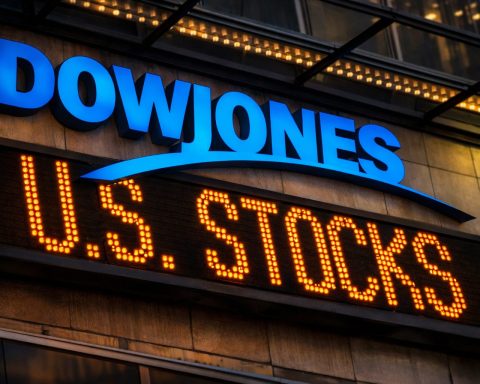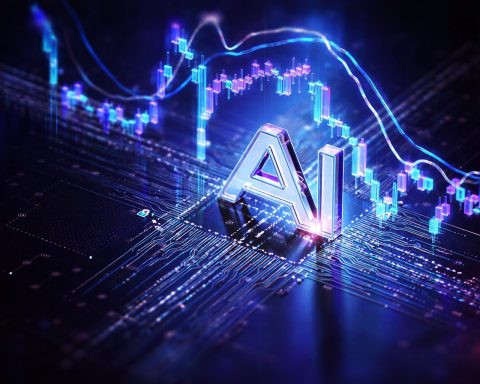- During Aug 21–22, 2025, the Nasdaq Composite and the S&P 500 tech sector each fell roughly 2% by Wednesday.
- Ahead of Fed Chair Jerome Powell’s Jackson Hole address, traders de-risked amid hopes of rate cuts.
- An MIT study found 95% of companies see no returns on AI spending, and OpenAI CEO Sam Altman cautioned investors may be overexcited.
- Tech stocks traded at about 30× forward earnings, a one-year high, prompting profit-taking and rotation into defensive names.
- Palantir Technologies entered a six-day losing streak, erasing about 17% of its value and becoming the S&P 500’s worst performer for the week.
- Nvidia shares fell about 5% for the week after a roughly 35% year-to-date rally through late August.
- Analog Devices rose 4% after reporting a 25% surge in revenue and boosting its outlook on AI-related chip demand.
- The White House confirmed talks to take a 10% government stake in Intel, converting part of the CHIPS Act grant into an ownership stake.
- Nvidia reportedly instructed Amkor and Samsung to halt production of the H20 AI chip to comply with U.S. export controls for China.
- Nvidia CEO Jensen Huang visited Taiwan to meet TSMC, and discussed a successor to the H20 chip rumored as B30A.
Tech Selloff Tests the AI Stock Boom
After a months-long AI-fueled rally, U.S. tech stocks hit a speed bump this week. The Nasdaq Composite and S&P 500 tech sector sank sharply mid-week – both down roughly 2%+ by Wednesday – as investors locked in gains [1]. This pullback comes amid seasonally weak late-August trading and jitters over the Fed. With Fed Chair Jerome Powell’s Jackson Hole speech looming, many traders de-risked in case he douses hopes of imminent rate cuts [2]. “When you have overcrowding and such strong performance, it doesn’t take much to see an unwind of that,” noted Keith Lerner of Truist Advisory, adding that “everyone is waiting for the Fed” before piling back into high-flying tech [3].
Warnings that the AI boom may be overheating also fueled the caution. An MIT study found 95% of companies are seeing no returns on their AI spending, and OpenAI CEO Sam Altman hinted that investors might be “overexcited” – suggesting some AI bubbles could emerge and pop [4]. Those headlines, coupled with stretched valuations (tech stocks recently hit ~30× forward earnings, a one-year high [5]), prompted a bout of profit-taking in crowded AI trades. The result: a broad rotation out of tech into defensive sectors [6], temporarily interrupting the “red-hot” AI stock rally.
High-Flying AI Darlings Face Reality Check
Some of 2025’s biggest AI winners suddenly skidded. Case in point: Palantir Technologies, a data analytics firm often touted as an “AI darling,” plunged in a six-day losing streak that erased about 17% of its value [7]. Palantir had skyrocketed 144% this year through early August, but its meteoric run-up left it vulnerable [8] [9]. The stock’s collapse – making it the S&P 500’s worst performer over the past week – handed a windfall to short sellers who had bet on an AI hype cooldown [10]. Famed short-seller Andrew Left blasted Palantir’s valuation as “absurd,” pointing out its price-to-sales multiple near 80× and a forward P/E around 290×. “I’ve stopped even looking at the ratio because it’s become so absurd,” Left said, predicting the stock could correct 50% or more from its peak [11]. His firm Citron Research argued that even if Palantir were “the greatest company ever,” its valuation would need to drop by two-thirds to begin aligning with reality [12]. Such skepticism from Wall Street’s bears has clearly taken some wind out of Palantir’s sails. (For its part, Palantir’s CEO insists demand for its AI platforms is at an “inflection point,” though investors are waiting to see that translate into actual revenue growth.)
Other AI high-flyers also hit air pockets. Nvidia – the poster child of the AI chip boom – saw its stock slide about 5% on the week amid the tech rout [13]. That’s a modest dip considering Nvidia’s shares had surged ~35% year-to-date by last week [14]. Still, the pullback shows how even market darlings are not immune to bouts of valuation anxiety. Smaller names were choppy too: enterprise AI software firms like C3.ai and UiPath swung lower alongside the broader sell-off, and other mega-caps from Apple to Meta took hits as well [15] [16]. Not all news was grim, though – Analog Devices (ADI), a lesser-known chip supplier, jumped 4% after reporting a 25% revenue surge and raising its outlook thanks to booming demand for AI-related chips in factory automation and autos [17]. This shows pockets of strength remain in the “picks and shovels” of AI even as the most hyped names cool off.
Chipmakers Grapple with Bold Moves and Geopolitics
The semiconductor sector – backbone of the AI revolution – landed in the spotlight with dramatic developments on multiple fronts. Major chip stocks (Nvidia, AMD, Intel, Micron) all declined on Aug 20 amid the tech sell-off and new uncertainties over government intervention in the industry [18]. Investors were digesting unprecedented moves by Washington: U.S. officials floated taking equity stakes in chip companies and skimming revenue from China-bound chip sales as a matter of national policy. In fact, the White House confirmed it is working on a deal for the government to acquire a 10% stake in Intel – essentially turning part of Intel’s CHIPS Act grant into a non-voting ownership stake [19]. This comes on the heels of President Donald Trump’s recent deal forcing Nvidia and AMD to hand over 15% of the revenue from advanced AI chip sales to China as an “export fee” [20]. Such heavy-handed measures mark a historic shift in U.S. industrial strategy, blurring the line between public and private sector in the chip space. “If Washington is willing to take a stake in Intel, it may be prepared to do the same in other ‘strategic’ companies,” one market strategist warned, as traders debated whether government stakes would ultimately prop up or dilute shareholder value [21] [22]. (Notably, Intel’s stock initially popped to a 6-month high on the 10% stake news – a $10 billion lifeline for the struggling giant – but those gains faded as broader tech weakness and dilution fears set in [23].)
Meanwhile, Nvidia is navigating a high-stakes tightrope in the U.S.–China tech standoff. This week brought a flurry of headlines about Nvidia’s China-focused AI chips. Reuters reported that Nvidia has told key suppliers to halt production of its H20 AI chip – a chip model custom-designed to meet U.S. export rules for China – according to sources cited by The Information [24]. Nvidia allegedly instructed Arizona-based Amkor (which handles advanced packaging for the H20) and even South Korea’s Samsung (its memory supplier) to suspend work on H20 orders [25]. The company responded carefully, saying it “constantly” manages its supply chain to match market conditions [26]. Nvidia also emphasized that the H20 is not a military or government chip, subtly pushing back on any notion that its China sales pose a national security risk [27]. The timing is delicate: just last week, Chinese regulators summoned domestic tech firms (like Tencent and ByteDance) to express concerns that Nvidia’s H20 chips could pose “information security” risks [28]. In other words, Nvidia faces pressure on both sides – Washington’s export curbs and Beijing’s tech nationalism – as it tries to serve the huge Chinese AI market.
Amid these cross-currents, Nvidia’s CEO Jensen Huang made a surprise visit to Taiwan on Friday. Huang flew into Taipei to meet with chip partner TSMC for a few hours of talks and dinner [29]. “My main purpose coming here is to visit TSMC,” he told reporters, reflecting the urgency of keeping Nvidia’s production pipeline humming despite geopolitics. He also hinted that Nvidia is developing a next-gen AI chip for China. Huang confirmed Nvidia is in discussions with U.S. authorities about offering a successor to the H20 chip, but stressed that approval is up to Washington. It’s “not the company’s decision” whether a more powerful new chip (rumored as the “B30A” based on Nvidia’s latest architecture) can be sold in China [30]. For Nvidia and its investors, the stakes are high – China accounted for about 13% of Nvidia’s revenue last year [31], and demand there is strong. The company is essentially engineering “China-only” products to comply with U.S. rules while still capturing business from Chinese cloud giants hungry for AI silicon. How this balancing act plays out – especially with Trump administration policies in flux – remains a key risk/reward question hovering over Nvidia’s stock. All eyes are now on Nvidia’s earnings report next week, which has become one of Wall Street’s most anticipated events [32]. Analysts have been racing to hike their targets on Nvidia, and options markets imply a big post-earnings swing. In short, the chip sector is ground-zero for the AI trade – and it’s being buffeted by everything from Fed policy to geopolitical chess moves.
Global Markets: China Earnings and European AI Jitters
AI news wasn’t confined to the U.S. – international developments also made waves. In China, internet search leader Baidu (often called China’s Google) reported its second-quarter results, and the numbers highlighted a mixed picture for AI. Baidu’s Q2 revenue fell 4% year-on-year to 32.7 billion yuan, slightly missing forecasts [33]. The culprit was a 15% plunge in online advertising sales, as China’s sluggish economy forced companies to slash ad budgets [34]. Baidu’s massive investments in AI have yet to pay off enough to fill that gap. On the bright side, the company’s AI-driven cloud business grew 27% to 6.5 billion yuan [35], and Baidu touted that its new AI initiatives pushed non-ad revenue above ¥10B for the first time. But that surge in AI cloud revenue still couldn’t offset the advertising slump [36]. “In the short term, AI will not fully offset advertising headwinds,” observed Eric Shen of Third Bridge, noting that tools like Baidu’s Ernie AI chatbot haven’t yet translated into meaningful ad dollars [37]. Baidu’s U.S.-listed shares slid about 3% on the report [38], as investors digested the reality that AI growth, while promising, is not a quick fix for all of Baidu’s challenges. Baidu’s CEO Robin Li struck an optimistic tone on the earnings call – saying the company will take a “prudent” approach to monetizing AI features to prioritize user experience – but he acknowledged that fully cashing in on AI will take time [39] [40]. For China’s markets at large, Baidu’s results were a microcosm of the AI paradox: huge long-term potential, but near-term financial returns are still ramping up.
Elsewhere, European markets felt the AI tremors too. In Europe, shares of established enterprise software companies – essentially the big “AI adopters” – came under pressure this week on fears that powerful new generative AI tools could disrupt those incumbents [41]. Investors are wrestling with questions like: Will upstart AI firms siphon business from legacy players (even as those incumbents scramble to launch AI features of their own)? This uncertainty contributed to modest declines in Europe’s tech indexes, even as broader continental markets were mixed. Notably, the U.K.’s FTSE 100 managed a 1% gain on Wednesday despite broader AI angst, aided by unrelated factors like strong retail earnings and a surprise uptick in UK inflation [42]. In Asia, Japan’s and Hong Kong’s indexes were likewise mixed [43], indicating that not all global markets were in risk-off mode – but the AI sector was a common thread in many regions’ market narratives. Even in countries where AI-specific stocks are scarce, the theme of AI disruption (and opportunity) is increasingly influencing investor sentiment across tech, media, and telecom sectors.
Outlook: Hype vs. Reality – What’s Next for the AI Trade?
Is this week’s shake-up a sign of AI bubble trouble, or just a healthy breather? Many experts believe it’s the latter. “These are price corrections… certainly not a ‘reckoning’ with the AI theme,” counseled Andrew Almeida of XYPN Investments, noting that the recent pullback hasn’t dented the long-term case for artificial intelligence [44]. Indeed, even as flashy AI stocks faltered, there are signs of deepening commitment to AI investment. Matt Stucky, portfolio manager at Northwestern Mutual, pointed out that several of the largest AI players have revised up their capital spending plans for late 2025 and 2026 – a vote of confidence that demand will only grow [45]. “The AI trade has staying power,” Stucky said, arguing that what we’re seeing is more of an expectations reset than any fundamental crack in the trend [46]. In other words, the secular boom in AI (from ChatGPT-like software to data-center chips and cloud services) remains intact, even if the stocks need to cool off periodically.
Analysts also emphasize that AI is now a global arms race among corporations – which could keep the momentum strong. Case in point: this week Google unveiled new AI-enhanced products, Microsoft inked an AI partnership with the NFL, and OpenAI announced plans for its first international office in India [47] [48]. Such developments signal that companies are doubling down on AI innovation and adoption, which ultimately filters into revenue and earnings. Of course, separating winners from losers will be key. Short-sellers like Andrew Left remain adamant that some AI hopefuls are wildly overvalued and due for a comeuppance if their profits don’t catch up [49]. And economic factors – from interest rates to trade policies – could yet deliver more surprises that whipsaw the sector in the near term. But so far, 2025’s AI stock mania hasn’t lost its underlying mojo. As one market watcher put it, it’s likely more of a rotation than a collapse: investors are temporarily favoring other sectors, but the enthusiasm for AI’s transformative potential is still running high. The coming days (and Nvidia’s earnings call) will shed more light on whether this week was just a speed bump on AI’s ascent – or the start of a more challenging new phase for the once-unstoppable AI trade.
Sources: Reuters [50] [51] [52] [53] [54] [55] [56] [57] [58] [59] [60] [61] [62] [63], Associated Press [64] [65], Bloomberg [66].
References
1. www.reuters.com, 2. www.reuters.com, 3. www.reuters.com, 4. www.reuters.com, 5. www.reuters.com, 6. www.reuters.com, 7. www.bloomberg.com, 8. www.businessinsider.com, 9. www.bloomberg.com, 10. www.bloomberg.com, 11. www.businessinsider.com, 12. www.businessinsider.com, 13. www.reuters.com, 14. www.asahi.com, 15. ts2.tech, 16. ts2.tech, 17. ts2.tech, 18. ts2.tech, 19. www.reuters.com, 20. www.reuters.com, 21. ts2.tech, 22. ts2.tech, 23. ts2.tech, 24. www.reuters.com, 25. www.reuters.com, 26. www.reuters.com, 27. www.reuters.com, 28. www.reuters.com, 29. www.reuters.com, 30. www.reuters.com, 31. ts2.tech, 32. www.asahi.com, 33. www.reuters.com, 34. www.reuters.com, 35. www.reuters.com, 36. www.reuters.com, 37. www.reuters.com, 38. www.reuters.com, 39. www.reuters.com, 40. www.reuters.com, 41. www.reuters.com, 42. www.asahi.com, 43. www.asahi.com, 44. www.reuters.com, 45. www.reuters.com, 46. www.reuters.com, 47. www.reuters.com, 48. www.reuters.com, 49. www.businessinsider.com, 50. www.reuters.com, 51. www.reuters.com, 52. www.reuters.com, 53. www.reuters.com, 54. www.reuters.com, 55. www.reuters.com, 56. www.reuters.com, 57. www.reuters.com, 58. www.reuters.com, 59. www.reuters.com, 60. www.reuters.com, 61. www.reuters.com, 62. www.businessinsider.com, 63. www.reuters.com, 64. www.asahi.com, 65. www.asahi.com, 66. www.bloomberg.com










